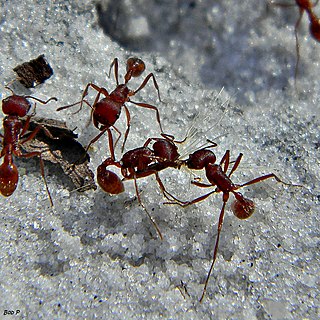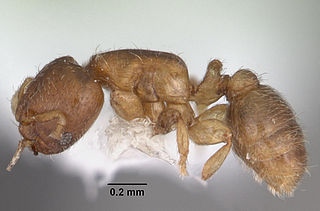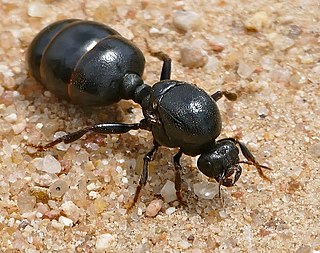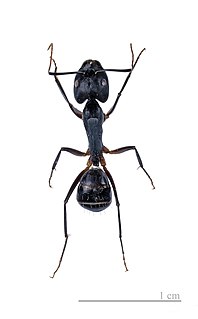
Myrmicinae is a subfamily of ants, with about 140 extant genera; their distribution is cosmopolitan. The pupae lack cocoons. Some species retain a functional sting. The petioles of Myrmicinae consist of two nodes. The nests are permanent and in soil, rotting wood, under stones, or in trees.

Harvester ant, also known as harvesting ant, is a common name for any of the species or genera of ants that collect seeds, or mushrooms as in the case of Euprenolepis procera, which are stored in the nest in communal chambers called granaries. They are also referred to as Agricultural ants. Seed harvesting by some desert ants is an adaptation to the lack of typical ant resources such as prey or honeydew from hemipterans. Harvester ants increase seed dispersal and protection, and provide nutrients that increase seedling survival of the desert plants. In addition, ants provide soil aeration through the creation of galleries and chambers, mix deep and upper layers of soil, and incorporate organic refuse into the soil.
Phragmosis is any method by which an animal defends itself in its burrow, by using its own body as a barrier. This term was originally coined by W.M. Wheeler (1927), while describing the defensive technique exhibited by insects. Wheeler observed the positioning of specially modified body structures to block nest entrances, as exhibited in various insect species. The term phragmosis has since been further extended beyond just insects.

Crematogastrini is a tribe of myrmicine ants with 64 genera and 8 fossil genera.

Pheidologeton diversus, also known as Carebara diversa, is a species of marauder ant widely distributed throughout Asia.

Ant-Man is a 2015 American superhero film based on the Marvel Comics characters of the same name: Scott Lang and Hank Pym. Produced by Marvel Studios and distributed by Walt Disney Studios Motion Pictures, it is the twelfth film in the Marvel Cinematic Universe (MCU). The film was directed by Peyton Reed, with a screenplay by the writing teams of Edgar Wright and Joe Cornish, and Adam McKay and Paul Rudd. It stars Rudd as Scott Lang / Ant-Man, alongside Evangeline Lilly, Corey Stoll, Bobby Cannavale, Michael Peña, Tip "T.I." Harris, Anthony Mackie, Wood Harris, Judy Greer, David Dastmalchian, and Michael Douglas as Hank Pym. In Ant-Man, Lang must help defend Pym's Ant-Man shrinking technology and plot a heist with worldwide ramifications.

Carebara is a genus of ants in the subfamily Myrmicinae. It is one of the largest myrmicine genera with more than 174 species distributed worldwide in the tropics and the Afrotropical region. Many of them are very tiny cryptic soil and leaf litter inhabitants. They nest in rotten wood to which the bark is still adherent in the Afrotropical region, or may be lestobiotic nesting near other ant species. Some species are known to exist parasitically within termite nests. Little is known about the biology of the species. However, they are notable for the vast difference in size between queens and workers.

Rhopalomastix is a genus of ants in the subfamily Myrmicinae. It is restricted to the Oriental and Indo-Australian regions, where the ants nest under the bark of living trees.

Carebara vidua is a species of ant in the subfamily Myrmicinae.
Carebara escherichi is a species of ants in the subfamily Formicinae. It is found in Sri Lanka.
Carebara bruni is a species of ants in the subfamily Formicinae. It is found in Sri Lanka and China.
Carebara butteli is a species of ants in the subfamily Formicinae. It is found in Sri Lanka.
Carebara ceylonensis is a species of ants in the subfamily Formicinae. It is found in Sri Lanka.
Carebara nana is a species of ants in the subfamily Formicinae. It is found in Sri Lanka.
Carebara pygmaea is a species of ants in the subfamily Formicinae. It is found in Sri Lanka, Borneo, Indonesia, Philippines.
Carebara sinhala is a species of ants in the subfamily Formicinae. It is found in Sri Lanka.
Carebara castanea is a species of ant from the Myrmicinae subfamily. The scientific name of this species was first published in 1858 by Smith. It is found in Thailand, Laos, and China.









